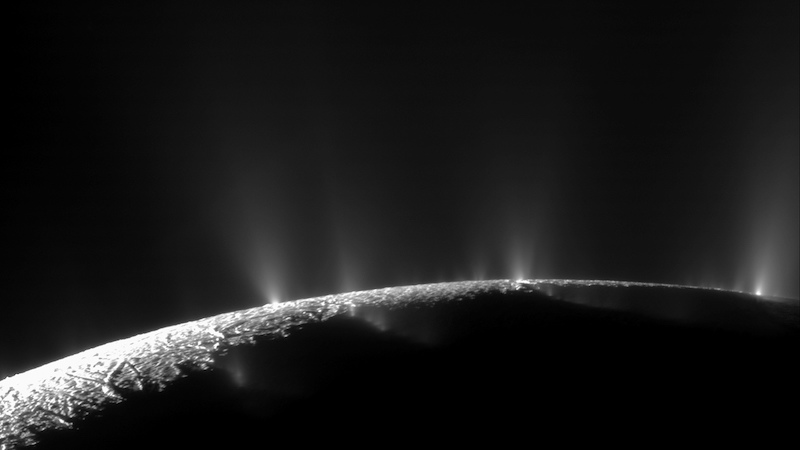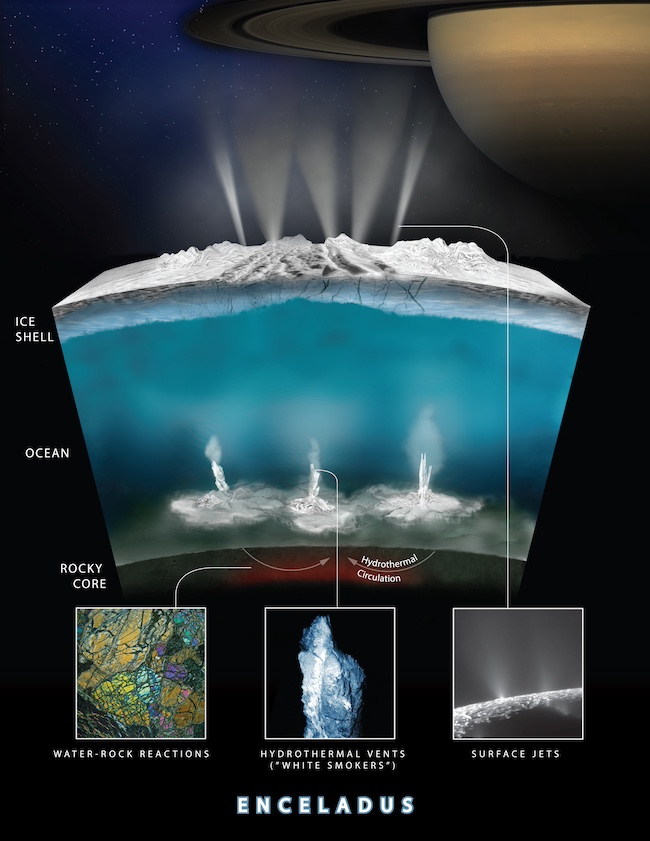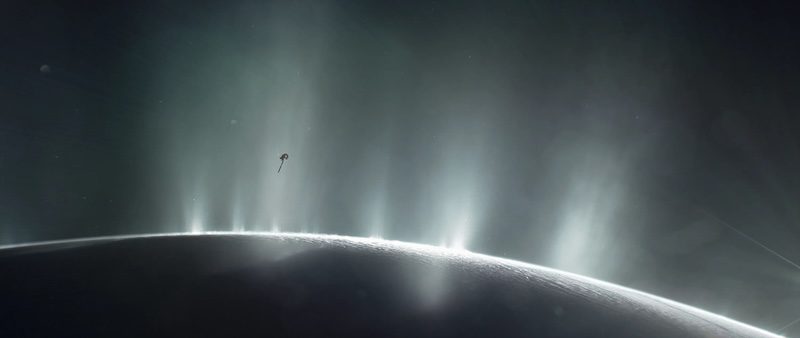- Saturn’s moon Enceladus has a global subsurface ocean and plumes of water vapor that erupt from the icy surface.
- The plumes could contain evidence of life that a spacecraft might find. But is it that easy?
- Traces of life might get trapped or altered in ocean layers before they ever reach the surface. This could make finding evidence for life a lot more difficult.
Signs of life on Enceladus might remain hidden in its ocean
The ocean moons in our solar system are some of the best places to search for evidence of alien life. But finding that evidence might not be as easy as first thought. That’s what researchers in the U.K. said on February 6, 2025, describing a new study that uses Saturn’s moon Enceladus as an example. A future spacecraft could sample the moon’s water vapor plumes directly, much like NASA’s Cassini mission did. But conditions inside the moon, where the ocean is, might make it difficult for traces of biological material to reach the surface where the plumes erupt into space.
The researchers also published their peer-reviewed results in Communications Earth & Environment on February 6.
A habitable environment for life on Enceladus
Saturn’s moon Enceladus has a global ocean beneath its outer icy crust, much like Jupiter’s moon Europa. The geyser-like plumes erupt through the surface at the moon’s south pole. This makes it easy for a spacecraft to sample the plumes directly, as NASA’s Cassini did previously. And scientists think the plumes originate from the ocean below. Cassini’s analysis provided tantalizing clues about conditions in the subsurface ocean. In fact, it found strong evidence for a habitable environment in that ocean. This included warm enough temperatures, salts (but not too much), complex organic molecules, ammonia, methane, phosphorus and evidence of hydrothermal vents on the seafloor.
It would seem then that life in Enceladus’ ocean is at least theoretically possible. Cassini wasn’t designed to specifically look for signs of life in Enceladus’ plumes. But the clues it did find are certainly tantalizing. And it seems reasonable that if there is any kind of life in the ocean, even just microbes, then sampling the plumes should be one of the best ways to find evidence for it. But the new study suggests it might not be that easy.

Enceladus study shows the physics of alien oceans could hide signs of life from spacecraft – phys.org/news/2025-02…
— Arizona Astrobiology Center (@azastrobiology.bsky.social) 2025-02-07T23:58:10.423Z
Layered ocean might be a barrier
The researchers found that Enceladus’ ocean is likely layered, and those layers don’t mix together very well. In oceans, stratification is the name for layers of water of different densities. That means even if traces of life did travel through the layers to the surface, they might break down or transform until they’re unrecognizable by the time they are ejected into space in the plumes. As the paper noted:
Water-vapor plumes erupting from Enceladus’ south pole provide a window into the properties of its subsurface ocean, a prime target in the search for life. However, the extent to which plume material represents conditions at Enceladus’ depths is unclear, because of its unknown ocean stratification, which may impede the transport of matter to the ocean top.
Flynn Ames, lead author at the University of Reading, explained:
Imagine trying to detect life at the depths of Earth’s oceans by only sampling water from the surface. That’s the challenge we face with Enceladus, except we’re also dealing with an ocean whose physics we do not fully understand.
We’ve found that Enceladus’ ocean should behave like oil and water in a jar, with layers that resist vertical mixing. These natural barriers could trap particles and chemical traces of life in the depths below for hundreds to hundreds of thousands of years. Previously, it was thought that these things could make their way efficiently to the ocean top within several months.
As the search for life continues, future space missions will need to be extra careful when sampling Enceladus’ surface waters.

Other ocean moons
It’s also possible that similar barriers could exist in the oceans of other moons as well. And if a moon didn’t have plumes like Enceladus does, that could make it even more difficult to find traces of life on its surface.
Europa, for example, has a thicker ice crust above its ocean. That could be even more problematic for any chemical or organic signatures to make it to the surface. And Europa might have plumes also, but scientists haven’t fully confirmed them yet (although the evidence is growing). We also don’t know if Europa’s ocean is layered in a way similar to that of Enceladus. Or any of the other oceans such those on Ganymede, Titan and others.
Bottom line: If there is any life on Enceladus, traces of it might remain hidden in ocean layers that prevent it from reaching the surface, a new study suggests.
Source: Ocean stratification impedes particulate transport to the plumes of Enceladus
Read more: Mystery dark spot on Enceladus intrigues scientists
Read more: Complex organics on Enceladus: A clue to possible life?
Source link
Read More
Visit Our Site
Read our previous article: Hypervelocity star drags fastest exoplanet through space at 1.2 million mph
